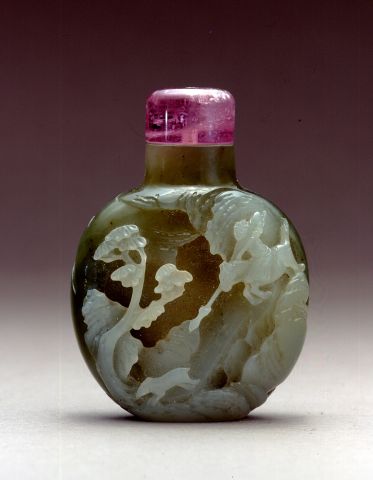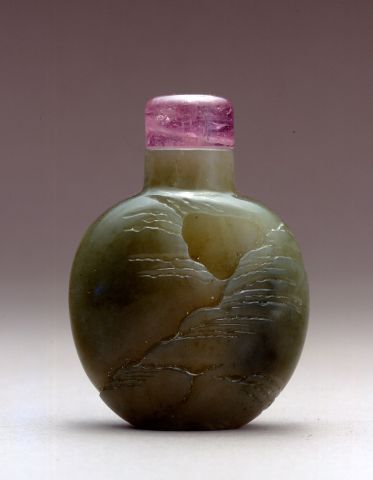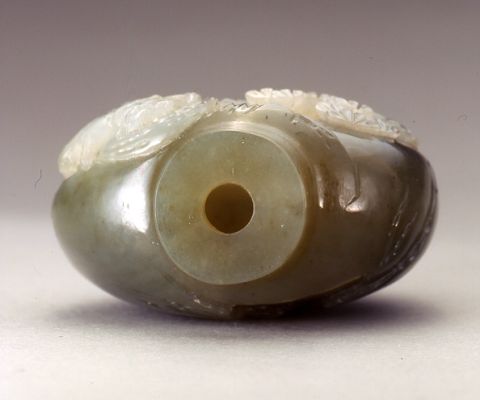


Bottle ID: 459
GREEN AND WHITE, HUNTER CHASING A DEER
Date: 1750-1800
Height: 50 mm
Nephrite, of greenish-gray tones with milky-white inclusions, very well hollowed, of ovoid form, carved in planes of relief with on one side a hunter astride his galloping steed, chasing a deer through a mountainous pine forest; the reverse with a bulging serrated rockwork, the base carved as a yin yang symbol using the two colors of the stone.
Attributed to the Suzhou School.
Similar Examples:
Crane Collection no. 85
Moss, Hugh, Victor Graham and Ka Bo Tsang. The Art of the Chinese Snuff Bottle - The J & J Collection, 1993, Vol. I, p. 74, no. 27.
Provenance:
Asian Art Studio
Jon Bloodworth
A private Californian Collection
Published:
JICSBS, Autumn 2007, front cover
In the eighteenth century Suzhou was an artistically thriving city; the demand for culture supported a market for artwork vying with the neighboring cities of Hangzhou and Yangzhou, of which the latter was exceptionally wealthy until 1810. Zhuanzhu Lane in Suzhou was known as the artist's quarter. In terms of production of jade it was the most flourishing centre in China. It does not imply any exclusivity in style however as there was almost certainly more than one workshop involved in carving in Zhuanzhu Lane. The privately owned workshops which depended both on the patronage of the wealthy and a stable supply of raw material had to cater to the taste of their customers, a culturally nouveau group. The development of jade carving in Suzhou is recorded in detail through the writings and poetry of the Qianlong Emperor. Consequently, it is known that after 1787 many carvers under the Emperor's influence began carving jade mountains or panels in what the Emperor called a 'pictorial mood'.
One of the classic features of the Suzhou School is rockwork. Whilst it is not a hard and fast rule that a Suzhou School bottle needs to have a rock of some form on it, many bottles do exhibit this characteristic. It is hardly surprising as Suzhou, often referred to as the 'City of Gardens' has more than its fair share of ornamental rocks even today. 'Cloud-Crowned Peak' is a 6.5 meter tall rock which weighs around 5 tons. It is lean, wrinkled hollowed and perforated. In the Song dynasty the stone-masons of Taihu Lake brought rocks from the mountains and chiseled them into different shapes. It is said that the rocks were then placed in the lake where the waves eventually rubbed them smooth. 'Cloud-Crowned Peak' was intended as a court tribute for the Imperial Garden in Beijing, but because it was so heavy it remained in Suzhou where it still stands beside two other rocks - 'Auspicious Cloud Peak' and 'Mountain Cloud Peak'. The three rocks are known as the 'Three Peaks of Liu Garden'. According to the 'Records of Suzhou Prefecture' in the Qing dynasty there were 130 such gardens in Suzhou.
Rockwork on bottles of the Suzhou School appear to fall into three types, often used in combination with each other - these are referred to as 'serrated' rockwork, 'convoluted' rockwork and 'multiple-plane' rockwork.
Serrated rockwork is a highly distinctive feature of this School where a series of dotted lines carved in low relief on almost over-lapping planes form the outline of the rock formation. This highly effective lapidary technique is almost unique to this School.
Convoluted rockwork appears on both Suzhou and Yangzhou School bottles. A subject beloved of the literati the rendition of archaic rock with its natural twists and turns is a powerful evocation of the sculptural style of the Schools.
Multiple-plane rockwork also appears on both the hardstone and glass examples of these Schools. This name refers to a highly three dimensional type of rockwork which is rendered on different planes by carving and polishing each plane in low relief towards the background of the bottle. In jade the play of light and shade is produced through the creative use of the darker inclusions or patches of color.
< Back to full list

 English
English 中文
中文